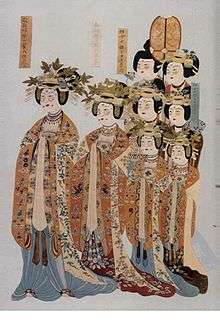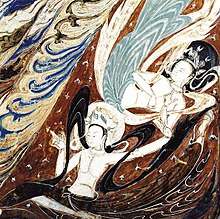Qixiong ruqun
Qixiong ruqun (simplified Chinese: 齐胸襦裙; traditional Chinese: 齊胸襦裙) is an ancient article of Chinese clothing, which is a kind of traditional dress of the Han Chinese. It is a unique ruqun type worn by women during the Sui dynasty, Tang dynasty and Five Dynasties. Since the Han dynasty and Jin (Chinese state), the waist of the skirt has always been tied on the waist, while in the Sui dynasty, Tang dynasty and Five Dynasties, the waistband of the dress was much higher, many of which were usually above the chest or under the armpit. Some records of clothing history refer to it as the high-waisted ruqun. Later, it was renamed to Qixiong ruqun, according to the current inspection and certification by people.[1][2]
Basic information
Qixiong ruqun is a ruqun (襦裙) style. In the Sui dynasty, Tang dynasty and Five Dynasties, it was named after its location. It is distinguished from the high-waisted Ruqun, which is attached below the chest and above the waist. Qiyao Ruqun is at the waist, and Qixiong Ruqun is under the armpit.[2]
In ancient times, ruqun dresses for women were not very high waisted, but ruqun dresses with very high waists appeared from the Northern and Southern dynasties to the Sui dynasty, Tang dynasty and Five Dynasties.[3] Some clothing history records call it the high-waisted Ruqun, and it was later changed to Qixiong ruqun according to the current people's examination and certification of it.
Tang dynasty was a dynasty with a prosperous economy and relatively open social fashion. Its costumes tended to be bright, colorful, and diverse,[4] So Qixiong ruqun is divided into two kinds, One is Duijin Qixiong ruqun (parallel collar type), and the other is the Jiaoling Qixiong ruqun (crossed collar type). Duijin Qixiong ruqun was and is generally more widely used.[1]
Qixiong ruqun is a representative costume of the Tang dynasty, which was very popular among Tang dynasty ladies. Many unearthed cultural relics and antique paintings have record it. For example, the famous picture Court Ladies Preparing Newly Woven Silkin the heyday of the Tang dynasty shows similar costumes.[5]
Clothing characteristic
Composition of Qixiong ruqun
Qixiong Ruqun is a style of ruqun. Ruqun consists of a blouse (Ru, 襦) and a round skirt (Qun, 裙; also known as Chang, 裳), it is a typical upper and lower garment system.[2] Because it must match the Qixiong skirt that was worn, blouses (Ru, 襦) were usually very short. The patterns on clothes also had different requirements according to the characteristics of different dynasties, for example, flowers and plants were often used as patterns in Tang dynasty.[6][7]

Qixiong ruqun accessories
- Hezi (诃子)
Qixiong ruqun has an accessory called Hezi. In Han costume, a woman's corset is tied from the back to the front, and the lower part has a rope so that the waist part of the skirt can be tied at the same time. Qing dynasty also is known as Dudou(肚兜). Hezi is one of the underwear of ancient Chinese women, famous in Tang dynasty, Song dynasty and Ming dynasty. In traditional Chinese culture, you can see similar costumes, which are used to decorate ruqun]. Examples of Hezi collocation are often found in ancient Chinese frescoes and cultural relics, for example. The famous Dunhuang(敦煌 )Mural.[8]

- Pibo (披帛)
Pibo is often used as decoration for Qixiong ruqun. Pibo evolved from a long shawl, and later gradually became a ribbon between the arms, this is the typical costume of ancient Chinese ladies. Pibo often appears in the murals of Sui dynasty and Tang dynasty, and Tang dynasty is the most popular period. It is made of silver or gold chiffon,[9][10] one end of which is fixed on the belt of the half arm then draped over the shoulder and wound around the arms. There are two kinds of Pibo: one type of banner is broader and shorter, which is mostly used by married women. Another can reach more than two meters in length, primarily used by unmarried women. Women's clothing styles in the middle and late Tang dynasty tend to be more and more loose and elegant, so most of them are decorated with Pibo.[10] It is a type of decoration that influenced the dupatta in India.
Daxiushan is also used to match the dress with the skirt, in ancient times, Qixiong ruqun with a Daxiushan can be worn as a formal dress. The material of Daxiushan upper garment is compared commonly flimsy. Its lace-up position is located in the lower part of clothing. This kind of dress can be seen in the Tang dynasty cultural relics silk painting "court ladies adorning their hair with flowers",[11] this work is from Zhou Fang, who was a very influential painter in the middle Tang dynasty. The cuff of Daxiushan upper garment has 4.37 feet above commonly.[12][13] The Tang dynasty was the heyday of economic, cultural, artistic, and diplomatic history in Chinese history. It also created the characteristics of this dynasty's freedom, gracefulness, and colorful clothing. Many costumes can be used with Daxiushan, which is commonly seen with narrow sleeves, straight sleeves and wide sleeves blouse (Ru, 襦).
History
Qixiong ruqun first appeared in the Northern and Southern dynasties, and was also used during the Sui dynasty, Tang dynasty, and Five Dynasties, until the Song dynasty, when, upon Neo-Confucianism's rise, it was eliminated from history, after about 1000 years of use. The styles of the straps are often found in pottery figurines or paintings unearthed before the Tang dynasty. Until the development of the Kaiyuan (开元) period of the Tang dynasty, when the style became fixed under the armpit.
During the Sui dynasty and Tang dynasty, blouses were generally worn as short Ru (襦), Banbi(半臂) (It belongs to the gown, Banbi's style is similar to the short-sleeved shirt, because its sleeve length is between long sleeves and sleeveless, it was called Banbi)[14] and Pibo (an accessory) both constituted an integral part of Ruqun at the time. During the Sui dynasty, Ru (襦) with short sleeves became a popular trend for the time.[9]
In the Tang dynasty, people wore short sleeved Ru (襦) and a floor-length skirt, but after the heyday of the Tang dynasty, the aristocratic costumes turned to become large and complex. The style of the skirt is stitched with four fabrics, the upper part is narrow, the lower part is loose, and the hem hangs down to the ground. Silk is used at the waist of the skirt, and laces are sewn at both ends. During this period, Ru (襦) neckline varied, and the most popular one was Daxiushan (大袖衫), which was full of the spirit of the people's ideological emancipation during the Tang dynasty. Skirt (Qun 裙) fabrics were mainly silk fabrics. The more expensive the materials, the better. The design of the waist of the skirt was much improved. The dresses of this period are brightly colored, the most popular of which were dark red, purple, moon green, grass green, etc. Among them, the color pomegranate red was famous for the longest time,[15] with various colors, and many differences, which were dazzling. For example, Emperor Zhongzong of Tang’s daughter, Princess Anle, had a skirt made up of the feathers of many types of birds, called Bainiao skirt (Qun 裙), which can be called a famous work in the history of Chinese weaving;[16] Zhou dynasty's bell skirt, which was decorated with twelve bells at the four corners of the dress.[17] When people walked, they made a "jingle" noise, which was seen as very graceful and beautiful. When the skirt (Qun, 裙), Ru (襦), and Pibo (披帛) are paired together, the woman's grace and temperament in the Tang dynasty were fully presented, showing a poetic beauty and rhythm.[14]
How to wear it
The style of ruqun is divided into one piece and two pieces, which are common in two parts. One piece is a traditional Chinese one-piece skirt, and the difference between the two sections is that it consists of two pieces of fabric. Presented as two skirts and two sets of lacing. So Qixiong ruqun's wearing method is different from the traditional one-piece skirt. First tie the rear section, then the front section.[18]
References
- 襦裙和深衣
- 襦裙的样式
- 那些被渐渐遗忘的汉文化
- 唐朝服饰研究
- Shanghai Daily
- 唐代佛教植物装饰纹样之艺术特色
- 朝服饰的常见纹样
- "Dunhuang Murals: gem in the world's history of art". SHINE.
- 中国服装史
- 披帛
- court ladies adorning their hair with flowers
- 唐代大袖衫 盛唐以后中国特色服饰
- 【漢服小課堂】齊胸襦裙 | 齐胸襦裙 | 齊胸衫裙
- 古代服装
- 华美服装艺术
- 这三条古代著名裙子,有一条让很多鸟类灭绝
- 没想到裙子的流行居然与武则天有关系
- How to Wear a Traditional Chinese Garment Called Qixiong Ruqun